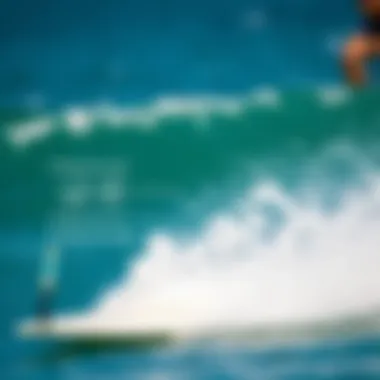The Importance of Boogie Board Wrist Leashes in Surfing


Intro
Surfing is more than just a sport; it's a lifestyle that requires the right gear to maximize enjoyment and safety. Among the various pieces of equipment surfers utilize, the boogie board wrist leash plays a crucial yet often overlooked role. This guide will unpack the significance of this accessory, helping both novices and experienced riders to appreciate its functionality. The right wrist leash contributes to safety and performance, allowing surfers to focus on their skills without worrying about losing their board amidst the waves.
Gear and Equipment
Choosing the right gear can make all the difference when surfing. The boogie board is undoubtedly central to the experience, but the items that support its use—like the wrist leash—certainly deserve attention.
Latest Surfboard Technologies
Modern surfboards have evolved dramatically, catered to various surfing styles and conditions. Innovations like lightweight materials, hydrodynamic shapes, and customizable fins enhance maneuverability. However, pairing these advanced boards with appropriate safety gear, such as a wrist leash, becomes even more crucial. A leash not only keeps your board within reach but also aligns with your board's capabilities, ensuring you can tackle any wave.
Essential Accessories for Every Surfer
It’s not just the surfboard itself that determines performance and enjoyment; accessories play a significant role too. Besides the leash, consider these must-have items:
- Surf Wax: Ensures an excellent grip on your board while riding.
- Board Bag: Protects your gear during transport.
- Fins: Critical for stability and controlling your ride.
- Wet Suit: Keeps you warm and protected from elements, enhancing your overall experience.
Each of these pieces complements the boogie board and wrist leash, creating a complete experience that allows surfers to ride safely and efficiently.
Important: Failure to use a suitable wrist leash can lead to accidents and losses, especially in crowded surf areas.
Surf Techniques and Skills
Once equipped with the right gear, it's time to hit the waves. The leash allows surfers to practice techniques without the anxiety of losing their board.
Beginner Surfing Techniques
For those just starting, mastering the basics is crucial. The wrist leash enables beginners to prioritize balance and form while catching waves. Techniques like paddling out, positioning on the board, and riding smaller waves can be practiced without fear. Additionally, securing yourself to the board with a reliable leash can cushion the learning curve, fostering confidence.
Advanced Maneuvers for Experienced Surfers
For seasoned surfers, the wrist leash can aid in executing complex tricks and maneuvers. From spins to flips, the leash keeps your board connected, allowing tighter turns and more fluid transitions. A well-chosen wrist leash ensures that surfers can push their limits without the worry of losing their equipment in the surf, enabling them to focus on the finesse of advanced techniques.
End
Understanding the pivotal role of a boogie board wrist leash in the surfing realm can significantly enhance your experience. It not only enriches safety but also complements every maneuver and technique you dare to try. The right leash, paired with the appropriate gear and honed skills, can help take your surfing to new heights. The ocean awaits, and being properly equipped gives you the freedom to explore its depths with confidence.
For more about surfing and gear, check out resources like Wikipedia or forums on Reddit.
Intro to Boogie Board Wrist Leashes
Every surfer knows that the ocean can be as unpredictable as a cat on a hot tin roof. That's where the boogie board wrist leash comes into play. It’s not merely a piece of equipment, but a lifeline that connects you to your board, helping prevent losing it in the waves—crucial for anyone who spends time riding the surf. As this article unfolds, we’re diving into the many facets of wrist leashes, from their definition to their benefits and everything in between.
Definition and Purpose
A boogie board wrist leash is a simple yet vital tool in the world of surfing and bodyboarding. Its primary purpose is to keep your board tethered to you, so when you wipe out, your board doesn’t go drifting off like a runaway kite.
Made from durable materials, wrist leashes are designed to withstand the gnarly conditions of the ocean. Most feature a strap that wraps securely around your wrist, connected by a strong cord to your board. This setup allows for agility and freedom of movement, balancing comfort and functionality. You could think of it as a safety net. In the hustle and bustle of riding waves, having that reassurance is worth its weight in gold.
History of Wrist Leashes in Surfing
The story of wrist leashes isn’t just a tale of safety; it’s a reflection of surf culture evolving over the decades. Way back in the day, surfers used to be more concerned about losing their boards than about the potential dangers of the sea. Leashes became common in the 1970s, when surfboard technology advanced, and people started to ride bigger and faster waves. Before then, surfers had to rely on skill to keep the board close.
As boards got lighter and faster, the need for wrist leashes rose significantly. The first leashes were mostly made of rubber or cord, which had their drawbacks—like being prone to snapping. Thankfully, surf gear manufacturers stepped up, innovating materials and designs for better performance and reliability. Nowadays, the modern leash is typically crafted from strong nylon or polyurethane materials, offering durability far surpassing its predecessors. This evolution mirrors the sport itself, which continues to adapt and grow, driven by the ocean’s eternal challenge.
Components of a Boogie Board Wrist Leash
A boogie board wrist leash might seem like a simple piece of equipment, but a closer look reveals how its components come together to provide essential functionality. This section dives into the various parts that constitute a wrist leash and their significance. By grasping the components, surfers can make informed decisions on what to look for, ensuring safety and optimum performance while riding the waves.
Wrist Strap Design


The wrist strap plays a crucial role in ensuring that the leash remains securely attached. Most straps are padded to offer comfort and prevent chafing, while flexibility allows for easier movement. You might find straps made from neoprene or a blend of materials designed to withstand water exposure and sun damage. While it may not jump out at you, the width of the strap also matters; a wider strap distributes pressure more evenly across the wrist, which can be especially important during long sessions on the water.
When assessing wrist strap designs, consider the buckle type. Velcro straps are common, providing adjustability, but they might not be as secure as metal or plastic clamps, which can be more reliable under stress. An established choice is the Body Glove Wrist Leash, known for its comfortable neoprene design and secure fastening mechanism, catering well to both comfort and functionality.
Leash Cord Material and Strength
The leash cord is where durability meets flexibility. It's generally made from either urethane or a strong nylon blend. Urethane is often touted for its elasticity, returning to shape after being stretched, which allows for a more dynamic surfing experience. On the other hand, nylon blends might be heavier but often offer additional abrasion resistance and resilience against the jagged edges of rocks or coral.
In evaluating leash material and strength, swimmers should also consider the thickness of the cord. A thinner cord might seem like a good way to reduce drag, but it’s critical to ensure it maintains adequate strength to withstand harsh conditions. An inadequate leash could snap at a critical moment and lead to losing your board and potentially causing injury to others.
Tip: Always check the manufacturer's specifications on the breaking strength of the leash. A good quality leash should have a tensile strength of at least 200 kg to handle the force during wipeouts or long rides.
Swivel Mechanism Importance
The swivel mechanism, often overlooked, plays a vital role in letting surfers maneouver freely without the cord tangling while catching waves. By allowing the leash to rotate, the swivel reduces resistance as you paddle out and ensures that your movements are fluid. If a leash doesn’t have this feature, you might find yourself constantly dealing with knots and twists, which can detract from focus and performance.
Most reliable brands incorporate a high-quality swivel made from corrosion-resistant stainless steel. This choice serves a dual purpose, as it offers durability and a smooth rotation that can withstand the challenges of saltwater and sand. Ideally, the swivels should be compact to reduce drag without sacrificing performance. Remember, no matter how good your leash is in other respects, if it gets tangled, it's a whole different ball game. Always check for smooth operation during leash maintenance.
In summary, understanding the components of a boogie board wrist leash is essential for every surfer. From the key role of the wrist strap to the importance of material strength and the swivel mechanism, each part contributes to the overall performance and safety. So, when selecting your next leash, consider these aspects seriously to enhance your experience on the waves.
Benefits of Using a Wrist Leash
A boogie board wrist leash is more than just a piece of equipment; it’s a critical accessory that can make or break your surfing experience. From enhanced safety to improved performance, the benefits of using a wrist leash are substantial. Riders often discover that integrating a wrist leash into their gear not only boosts convenience but also deepens their connection to the surf. Understanding these benefits is essential for both novice surfers and seasoned veterans.
Safety Considerations
Safety in the water should always be a top priority for any boogie boarder. A wrist leash functions as a lifeline during moments of turbulence. In rough conditions or when the waves get choppy, a loose board can become a hazard, knocking into swimmers or other surfers. By adhering your board to your wrist, you significantly reduce the risk of it getting away from you. This means less chance of injury—not just for yourself but also for others around you.
Moreover, a wrist leash ensures you don't have to chase down your board after a wipeout. Instead of swimming frantically through strong currents, you can focus on regaining your composure and planning your next ride. With a reliable wrist leash, you can trust that your board will stay close, allowing you to prioritize your safety while enjoying the surf.
"A wrist leash isn’t just gear; it’s your partner in the waves, keeping you and your board safely tethered."
Enhanced Performance and Control
The benefits of a wrist leash extend beyond safety; they play a crucial role in enhancing performance as well. When you’re out there in the surf, having your board attached to your wrist allows for greater control over your maneuvers. If you lose your balance or wipe out, instead of struggling to retrieve your board, it’s right there, allowing you to reset quickly and get back into the flow.
Using a leash means you can engage more dynamically with the waves. You don’t have to worry about losing your board or orienting yourself, which can often disrupt your rhythm. Whether you’re carving up a wave or tackling a trick, knowing that your board is securely tethered lets you focus entirely on your ride. Some even argue that a vinyl leash adds a unique level of style, keeping you in tune with the aesthetics of the ocean.
Convenience for Boogie Boarders
Convenience is another undeniable benefit of using a wrist leash. When you’re out in the surf, the last thing you want to do is waste time retrieving your equipment. A wrist leash keeps things simple and efficient. It allows you to grab your board quickly after a tumble, letting you rejoin the action without missing a beat. This is incredibly important when surf conditions change rapidly, and opportunities for the ideal wave come and go in the blink of an eye.
Additionally, with a wrist leash, you can easily transition from riding waves back to paddling without interruptions. Knowing your board is securely attached can help maintain a steady pace and effective movements, which leads to a better overall surfing experience.
In summary, the benefits of wearing a boogie board wrist leash are multifaceted. From boosting your safety profile to enhancing performance and providing unmatched convenience, a wrist leash is truly a worthwhile investment for surfers of all abilities.
Selecting the Right Wrist Leash
Choosing the right wrist leash for your boogie board can be a game changer, whether you're just beginning or have been carving waves for years. Your wrist leash acts as the bridge between you and your board, ensuring that you stay connected even in the most tumultuous waters. Each surfer has their unique style and preferences, so understanding how to select a wrist leash tailored to your needs is crucial for both safety and performance.
Assessing Your Surfing Style
Your surfing style directly influences the type of wrist leash that will suit you best. For instance, if you're a more aggressive surfer who loves to tackle big waves, a leash with greater thickness may be essential. Conversely, if you're a recreational rider who enjoys gentle swells, a thinner model might suffice. Think about how you typically ride; are you a daredevil who enjoys tricks or are you more of a smooth cruiser? Robust leashes are often made for hardcore maneuverability, while lighter options cater to casual gliding.
Key points for assessment:
- Wave Conditions: Consider what type of waves you usually ride in. Heavy waves may require sturdier leashes.
- Trick Performance: If you throw tricks, find leashes that won’t hinder your movement.
Length and Thickness Considerations
The dimensions of the leash are also paramount in your decision-making. Generally speaking, a standard length for boogie board leashes is around 5 to 6 feet. Choosing a length that complements your specific board size and riding style can make a noticeable difference in your overall control in the water.


When it comes to thickness, leashes generally vary from 6 mm to 10 mm. Thicker leashes provide better security and are less likely to snap in challenging conditions. However, they also add some bulk which might not appeal to every surfer.
Important considerations:
- Board Size: Ensure the leash length matches your board size for optimum safety.
- Wave Size: Bigger waves often require thicker leashes to withstand extra forces.
Evaluating Durability and Weather Resistance
Surfing often means dealing with various weather conditions and environments. Therefore, considering the durability and weather resistance of your leash is essential. A quality boogie board wrist leash should withstand not only the regular wear and tear of ocean exposure but also resist water damage like rust or corrosion.
Materials such as neoprene provide a comfortable fit but also hold up against saltwater. Notably, look at the leash's attachment points to ensure they can endure intense pulling.
Points to evaluate:
- Material: Inspect the material for durability, especially if you frequent harsher conditions.
- Attachment Mechanism: Strong clips and swivel designs can elevate durability significantly.
Accepting that the right wrist leash serves the surfer’s unique demands can enhance not only performance but also safety. Each element—the style, dimensions, and durability—works together to create a seamless experience on the waves.
Maintenance of Your Wrist Leash
Taking care of your boogie board wrist leash is just as vital as choosing the right one. Regular maintenance can boost its lifespan and ensure that it performs effectively when you’re out in the waves. A well-maintained leash not only serves its purpose but also enhances your overall surfing experience. Preventing issues before they arise is key to safety and functionality while surfing.
Cleaning Techniques
To keep your wrist leash in tip-top shape, washing it after each surf session is a must. Saltwater and sand can wear down the materials over time. Use fresh water to rinse off the leash thoroughly. You might think that a quick splash won’t do the trick, but it’s not just a surface cleaning; you want to get into crevices where sand hides. Here’s a simple step-by-step:
- Remove the leash from the board.
- Rinse it under fresh water.
- Use mild soap and a soft cloth to scrub if you notice any stubborn dirt.
- Rinse again, ensuring no soap is left behind.
- Hang it to dry in a shaded spot to prevent UV damage from the sun.
This routine can significantly prolong the durability of your leash and maintain its flexibility.
Inspecting for Wear and Tear
Don’t wait for your leash to fail mid-surf before you check it out. Inspecting for wear and tear should be part of your pre-surf ritual. Look closely at both the wrist strap and the cord. If you notice cracks, frays, or any weakening spots, those could spell trouble. Be especially mindful of:
- Stitching: This usually shows the first signs of fatigue.
- Material integrity: Is it still stretchy, or does it feel brittle?
- Swivel mechanism: Ensure it’s rotating freely without any resistance.
A good habit is to run your hands along the leash each time you’re about to hit the water. A quick check can save you from a possible mishap and safeguard your surfing adventure.
Storage Practices
How you store your wrist leash can make a world of difference in its life span. After cleaning and drying, store your wrist leash flat or coiled loosely in a dry place. Avoid hanging it up or leaving it in direct sunlight for long periods, as this can lead to unnecessary degradation. Here’s a shortlist of storage do’s and don’ts:
- Do: Keep it in a cool, dry place away from direct sunlight.
- Don’t: Leave it tangled with other gear, as this can cause kinks and damage.
- Do: Use a small mesh bag for storage to allow air circulation.
By following these simple strategies, you ensure that your wrist leash remains ready for your next ocean adventure. Proper maintenance isn’t just about care; it’s about enhancing your performance and safety in the water.
Common Misconceptions About Wrist Leashes
When it comes to boogie boarding, the wrist leash is often surrounded by a bit of chatter that isn’t wholly accurate. Understanding these misconceptions is crucial for both safety and performance in the surf. Let’s unravel some common myths that might cloud your judgment when it comes to this essential piece of gear.
Overestimation of Security
One of the biggest misunderstandings about wrist leashes is that they provide a foolproof guarantee of security in the water. Many enthusiasts think that once attached, there’s no way their board could drift away, but that’s not entirely true. Waves can be relentless and powerful. In the event of a wipeout or strong currents, there’s a chance that the leash could snap or come undone. Obviously, this isn't common, especially with well-constructed leashes, but it's important to remember that they are not an impenetrable force field.
- Key Points to Consider:
- Always check the leash for any signs of wear before heading into the water.
- Know your limits; heavy surf can test the leash's strength.
- Don’t depend solely on the leash—practice good safety habits.
"A wrist leash is like a safety net; it helps, but it won't catch every fall."
Weight and Bulk Concerns


Another misconception that often crops up is the idea that wrist leashes add unnecessary weight and bulk to the boogie board experience, hindering performance and maneuverability. While it’s true that some lower-quality leashes can feel cumbersome, a well-designed leash should fit like a glove.
- Things to Keep in Mind:
- Premium leashes are made with lightweight materials that enhance performance.
- The bulkiness can depend on personal preference and the specific activities you’re pursuing.
- A properly attached leash does not obstruct movement; if it does, consider reevaluating your choice.
Compatibility with Other Gear
There’s often a fear that using a wrist leash might restrict compatibility with other surfing gear, like fins or specific board types. The fact is, most wrist leashes are designed to be versatile. There are a variety of lengths, thicknesses, and attachment styles that can cater to your preferred setup.
- Compatibility Factors to Consider:
- Ensure you choose a leash that matches the length and width of your board.
- Explore adjustable options if you frequently change your equipment.
- If you're trying a different board or other gear, don’t hesitate to ask for advice at your local surf shop.
In wrapping up this segment, addressing these misconceptions does more than clear the air. It empowers you to approach your surf sessions with the right knowledge, making your experience safer and more enjoyable. A wrist leash is a tool, and like any tool, understanding how to use it properly is key.
Comparing Different Types of Leashes
In the realm of boogie boarding, the leash you choose holds significant weight. Not all wrist leashes are created equal, and understanding the nuances can greatly impact your overall surfing experience. This section looks into the various types of leashes available, focusing on their distinct characteristics, advantages, and what one should consider when making a selection.
Coiled vs. Straight Leashes
When it comes to the style of leashes, the debate usually leads to coiled versus straight leashes. Each has its merits, tailored for different scenarios and preferences.
Coiled leashes are designed specifically to remain retractable. With their spiral structure, they help in minimizing drag in the water. This can be a game-changer for speedsters who enjoy racing through waves without any resistance slowing them down. Coiled leashes tend to stay out of the way while surfing, preventing tangles and potential accidents.
On the other hand, straight leashes provide a more traditional feel. They flow naturally in the water and are generally regarded as more reliable for those who prefer a tried-and-true method. They may not eliminate drag as effectively as coiled ones, but they excel in durability. This makes them a preferred choice for surfers who engage in rigorous activities, as they can provide a sturdy connection.
Some differences worth noting include:
- Tangle Potential: Coiled leashes are less likely to get tangled, while straight leashes, if not managed well, could become a hassle.
- Experience Level Compatibility: Novice surfers often lean towards coiled leashes for ease, while more experienced boogie boarders may opt for straight leashes for the control it offers.
Premium vs. Standard Models
As you explore the market, you'll come across premium models alongside standard ones. This division can influence your ultimate choice in significant ways.
Premium leashes tend to come with enhanced features and materials, offering better resilience against wear and tear. For instance, brands like Dakine are known for leashes that incorporate advanced safes and designs that prioritize both performance and security. Their build often includes reinforced stitching and superior cord material, appealing to the committed surfer who doesn't mind investing in quality.
In contrast, standard models are more budget-friendly, often targeting beginners or those who just kick off their surfing journey. While they fulfill the basic requirements, they might lack the longevity and performance features of premium options. You might find yourself replacing a standard leash sooner if you're surfing regularly or engaging in high-stakes water conditions.
Key things to consider:
- Usage Frequency: Casual surfers might not need premium leashes if they only hit the waves a few times a year.
- Environment: If you're surfing in rocky areas, opting for a premium model could save you some headaches in the long run.
- Total Cost Effectiveness: Sometimes, spending a bit more upfront can translate into savings over time by avoiding frequent replacements.
Ultimately, comparing coiled versus straight and premium versus standard leashes can help in making an informed decision that aligns with your surfing style and preference.
Selecting the right type of leash is not just about personal preference; it can greatly affect your performance and enjoyment in the water.
The End: The Indispensable Boogie Board Wrist Leash
In the concluding portion of this article, we find ourselves reflecting on the critical role that a boogie board wrist leash plays in enhancing the surfing experience. It goes beyond merely keeping your board close; it is a vital component of safety, performance, and overall enjoyment while riding the waves. As we’ve explored throughout, choosing the right wrist leash is not just about style but about aligning with personal surfing preferences and conditions.
Understanding its importance can be visualized as securing a seatbelt before a drive. Just as a seatbelt offers protection and peace of mind, a wrist leash keeps your board attached to you, providing a sense of security against unpredictable surf conditions.
Key Takeaways
- Safety First: The wrist leash acts as a lifeline, minimizing the risk of losing your board to raging surf. This is particularly paramount in crowded waters where losing your board could lead to accidents.
- Performance Enhancement: A well-selected leash contributes to fluid movements in the water, allowing surfers to focus on technique rather than worrying about their gear drifting away.
- Convenience: The ease of use and the ability to retrieve your board swiftly after a wipeout makes the wrist leash an indispensable ally in the waves.
Alongside these considerations, durability and quality are non-negotiable. Investing in a premium leash that withstands harsh environments pays off in the long run.
Final Thoughts on Safety and Performance
When it boils down to it, the boogie board wrist leash is far more than an accessory; it is an essential tool for serious surfers. Opting for a leash that complements your riding style can lead to improvements in maneuverability and confidence while out on the water.
The takeaway here is a clear one: don’t sideline this crucial piece of equipment. Like shoes for running or helmets for biking, a wrist leash is a must-have for safety and enhanced performance in boogie boarding. The waves can be unpredictable, but having a solid connection to your board means you're prepared to ride through both the calm and the storm.
Ultimately, being mindful of the right choices regarding your wrist leash can spell the difference between a challenging outing and a successful, enjoyable day at sea. For those who truly appreciate the thrill of surfing, understanding and utilizing a wrist leash effectively mirrors a commitment to the sport, striking a balance between enjoyment and safety.







